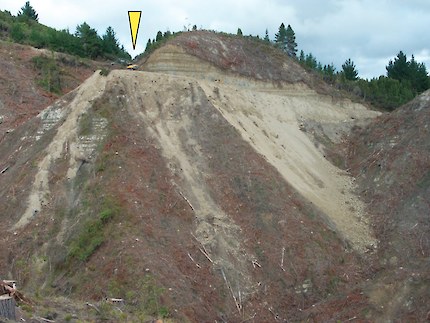Full bench construction removes all the fill, so the road is built on the hard. These roads create large volumes of spoil that needs to be carted away (end-hauled).
Diagram 3: End-haul (full bench) construction to eliminate fill

- End-haul is expensive. Reduce costs by having a place close by to dump spoil
- Full bench creates large cut slopes
When should end-haul be used?
- When slopes are too steep or unstable to place fill
- When the risk of fill failure is unacceptable. For example, when close to a stream
- Caution: Full bench can create road instability in some soil types. For example, in earth flow terrain

- Full benching would have stopped the spoil reaching the watercourse
- Side slopes were too steep to hold the fill, so it spilt to the bottom of the slope
- The arrow points to an excavator
Diagram 4: End-haul road construction methods


- Effective one pass team. A dump truck and a close spoil dumping area kept costs down

- A dump truck was used to maximise the load. Its tyres also help with compaction
- The spoil was dumped at a close and well-prepared location